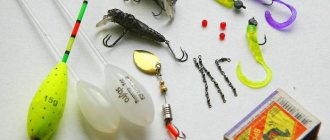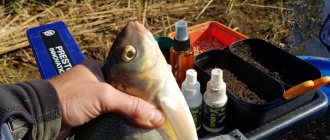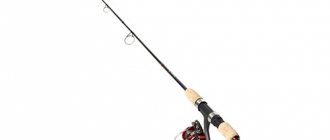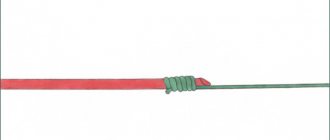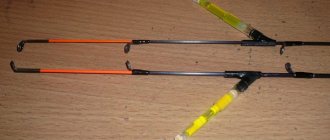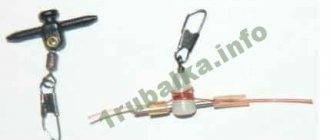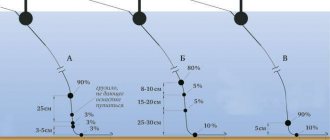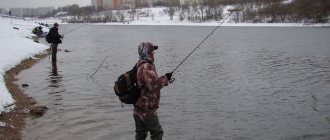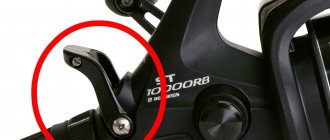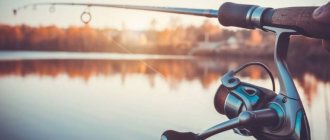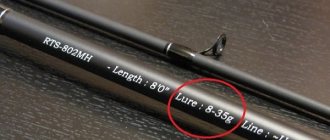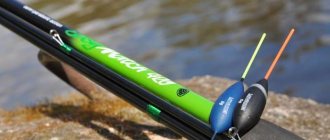Successful fishing with a Bolognese fishing rod will be a pleasure, you just need to choose the right gear. The reel, of course, plays a significant role; the success of fishing also depends on it. Often in fishing stores, one’s eyes simply run wide from the rich assortment of gear, including reels. Cheap and expensive, inertia-free and ordinary, they attract our attention. But the eyes of an experienced 34fish.ru fisherman will stop at the reels that will fit the Bolognese fishing rod, and from them he will choose the one he needs.
About reels for a Bolognese fishing rod
Initially, the reel was considered the “keeper” of the fishing line. However, developing technologies have added many more functions to it. The reel now affects not only the casting distance, but has also become an assistant in landing large fish.
She began to look different from before. Here we are talking, first of all, about the materials from which the reel is made: bronze, ceramics, plastic. Its technical characteristics have also changed. You can read the material about fishing with a Bolognese fishing rod.
Practical purpose
Having figured out and decided on your own acceptable price range for reels, you can proceed directly to answering the question “How to choose a reel for a fishing rod?” In order to answer this question correctly and more fully, it is necessary to divide fishing with a rod into the following main types:
1. Fishing with a fly rod. The progenitor of this rod is the same rod made of hazel or bamboo described earlier. Therefore, in order to engage in such fishing, a reel is completely unnecessary. The fly rod is absolutely devoid of guide rings, and the fishing line is tied directly to the connector located at the tip of the rod. This method of fishing, although it does not involve catching trophy fish, is in turn very interesting and exciting;
2. Fishing with a plug rod. Similar to the fly rod, this fishing rod does not have guide rings on the form and does not require the use of any reels. This method of fishing is quite unique. And, although a sufficient number of amateur fishermen are engaged in it, nevertheless, it has received greater use among professional fishermen involved in sports;
3. Fishing with a Bolognese rod. Unlike the previous two, this rod has a place for attaching a reel. The specifics of this fishing method involve the use of light weights and a close fishing distance. This means that it is not demanding on such reel parameters as power, gear ratio and spool capacity. If we take a closer look, we can highlight the following points:
- There is no need for power reserve, because when casting light equipment, the reel does not experience any overload at all;
- Since the fishing distance is short, high-speed reeling of the tackle is not required. The optimal gear ratio would be the “golden mean” - about 5.2:1;
- Since the casts are short distances, there is no need for the spool to hold a lot of line. If you choose reels of size 4000 and above, you will need to additionally wind the backing, because Fishing with a Bolognese fishing rod does not involve the use of large diameter fishing lines and unwindings. The optimal spinning reel for a fishing rod size 1000 – 3000;
- Because Most of the time the rod is in the hands, it is still preferable to use fairly light reel models;
- The location of the clutch doesn't matter and is more of a matter of personal preference;
- There is no need for a large number of bearings, since the loads are minimal, and each additional bearing adds a certain price to the reel. It is enough for the reel to have 3-4 bearings.
- Summarizing the characteristics required of reels in this fishing method, we can conclude that inertial reels will also be quite appropriate. These reels outperform spinning reels in terms of reliability, simplicity and lower cost;
4. Fishing with a match rod. In appearance, this fishing rod is very similar to the design of a spinning rod. It is not advisable to use inertial reels for fishing rods in this case because fishing takes place at a considerable distance from the shore. As for inertia-free, the following can be noted:
- The spool should hold a lot of fishing line, therefore, it would be optimal to use reels of size 2000 - 3000;
- A wide spool with a low profile is preferable because... it is this that has a positive effect on casting distance;
- Must be powerful enough to withstand heavy loads on the friction clutch;
- Speed is also important, because... the fishing line is reeled out from long distances;
- The weight of the reel must match the rod so that the tackle is balanced;
- The location of the clutch is not important, but here it is already quite important that its operation is smooth and easy to adjust;
- It is desirable to have at least four bearings located in the main components of the reel.
5. Fishing with a feeder rod. Feeder fishing involves frequent casting of heavy feeders with bait, so the requirements for reels are appropriate:
- The optimal size is 4000. This is due to the need for long casts, high power and speed of reeling out the line;
- As in match fishing, a low-profile spool is more preferable;
- The weight must match the rod used;
- The gear ratio must balance between speed and power. The optimal value is up to 5.2 to 1;
- The quality of line laying must be at a high level, because... The casting distance and the likelihood of “beard” formation will depend on this. It is worth giving preference to a reel with an endless screw.
Gallery: Bolognese fishing rod reel (25 photos)
Simple inertial coil
For fishing in weak currents, from a boat, in still water, a simple inertial reel is suitable - this is a small drum. It is light, its base is metal with a spool with a diameter of 3 - 7 cm. It does not have a clutch that releases the line, and therefore it will be difficult to take large fish with such a reel.
Friction brake of reels
The most important element of a spinning reel is the friction brake. Since fishing is carried out with fishing lines with a thickness of 0.1 mm or less, ultra-fine adjustment of the clutch is necessary. If when fishing with donks and feeders it is better to use models in which the friction is adjusted by several turns, then in the case of float rods it is better to install reels with a thinner clutch. It is adjustable with 4-6 turns. We pay special attention to this element. If you adjust the clutch incorrectly, then loss of leads is inevitable.
If you see that a larger fish than usual is caught on the hook, you can tighten the clutch a little. If you use leashes made of elastic monofilament, which stretch better, you will deliver the trophy to the landing net. But again, fine-tuning the drag while fishing is best achieved with match reels.
There is no consensus on which clutch is best to use. Whoever is more comfortable uses that one. For some it is easier to tighten the front clutch, and for others it is easier to tighten the rear clutch.
Wiring inertial coil
A wiring coil is also suitable, also inertial, but the material from which it is made is more durable and complex in structure. If the model is made of high quality, the reel will have bearings with a rotating spool. This is an ideal option for fishing in the current. The hook with bait is thrown into the water and the current itself unwinds the fishing line, all that remains is to reel it in towards you. The main thing is that the coil (wiring) works smoothly and easily. You can read the material about the Bolognese fishing rod.
Complete set and installation of gear
After purchasing the rod itself, you need to start preparing the remaining components, including the reel, fishing line, float, sinkers and hooks. First things first:
- As a reel, you can use any spinning reel with a wide, capacious spool and an adjustable friction brake. An excellent solution could be a rear-friction reel equipped with a wide spool with a high gear ratio. The spool must have at least 100 meters of fishing line wound on it.
- The optimal thickness of the fishing line varies in the range of 0.14−0.18 mm. For the leader material, you can use fluorocarbon line with a cross section of 0.12 mm. For fishing in intense currents, you should use a floating line, and for standing water, a sinking line.
- The hooks you choose should be as reliable and sharp as possible, and their size should correspond to the size of the fish found in the pond.
The choice of float is another important point that needs to be given special attention. For lap dogs, it is customary to use two types of floats: sliding and stationary. The sliding version has one point of contact with the fishing line, so it moves freely along it. Silicone stops are used to regulate movement. One of the advantages of such floats is the absence of the need to constantly change the depth, because they support independent adjustment depending on the location. These products are quite large and equipped with a bright tip that can be seen from great distances. The disadvantage is low sensitivity for subtle bites.
As for stationary floats, they are much more sensitive and react to the slightest pulls of the inhabitants of the depths. Such models have three points of contact with the working line. Drop-shaped or pear-shaped models are used as catching forms. To be fully equipped, it is advisable to take both varieties for fishing at once, changing them if necessary.
Multiplier reel
It is good for spinning and trolling. The advantages of such a coil are defined as:
- greatest sensitivity when fishing;
- withstands heavy loads, unlike inertial ones;
- light;
- it has a longer casting range.
In a word, this is the same inertial coil only of an improved model.
The multiplier itself consists of:
- line counter;
- braking spool;
- changes in gear ratio.
The reel is attached to the top of the rod, then you can feel a weak bite. This reel also has its downsides. Firstly, it is difficult to hold in your hand. Secondly, it is more difficult to configure. There's no need for experience here.
Inertial
In fact, an inertial reel is good for Bolognese fishing. With such a coil it is good to control the wiring; with the advent of modern technologies, inertial coils have become more “long-range”, and they are also very easy to maintain. For example, if you drop such a reel in the sand, you can safely remove it and wash it in a pond.
Despite many advantages, inertia engines have their disadvantages:
- The first and most important drawback is the casting range, although technology has stepped forward, you can’t argue with physics, so an inertia-free reel casts the equipment much further.
- Also, handling such reels requires certain skills, and even experienced fishermen can get a little distracted and tangle the line.
- The price of modern inertial coils, despite their simplicity, is quite high.
Where to use and how to choose
The use of such coils is quite limited. If you are fishing on a large river from the shore, then you may need to cast far, and here the inertial reel loses.
If fishing is done from a boat or from a bridge, where long casting is not required, an inertial cast will be an ideal option. This type of reel is also suitable for fishing on small rivers, where if you cast the equipment harder, you can throw it to the other bank.
When choosing an inertial reel, you should pay attention to its weight. Heavy models will not be able to give off enough line when fishing with light equipment; this is important when fishing on small rivers.
A spool that is too light, on the contrary, will unwind unnecessarily, so it will have to be constantly monitored. You should also pay attention to the presence of bearings. Cheaper models without bearings will have to be checked and lubricated before each fishing trip.
Adviсe
- The reel should be stored away from dampness.
- Once a year, open the reel and lubricate its mechanism with oil.
- The coil is used only for its intended purpose; you should not experiment with it.
- After fishing, the reel needs to be cleaned of dirt, wiped and dried.
- If the reel is stored and transported correctly (preferably in a case), it will serve for a long time.
And finally
Advice from salespeople in specialized stores is not always true. Therefore, feel free to choose a spinning reel for your Bolognese fishing rod - this is an easy and reliable option. Let's say more, the Daiwa Megaforce X 2500 will undoubtedly suit you.
Size
The spool size should be about 55mm. This is a compromise between the mass of the reel and the speed of reeling in the line. The larger the spool diameter, the higher the speed. A high reeling speed is important for this type of fishing, since frequent recasts are performed over a considerable distance. The equipment has to be reeled in frequently and quickly; the reel should help the fisherman with this. The spool depth should be small to avoid backing. Traction properties are also of secondary importance, since the equipment is light and there are no high loads. Pumping and drag are designed to cope with large fish.
